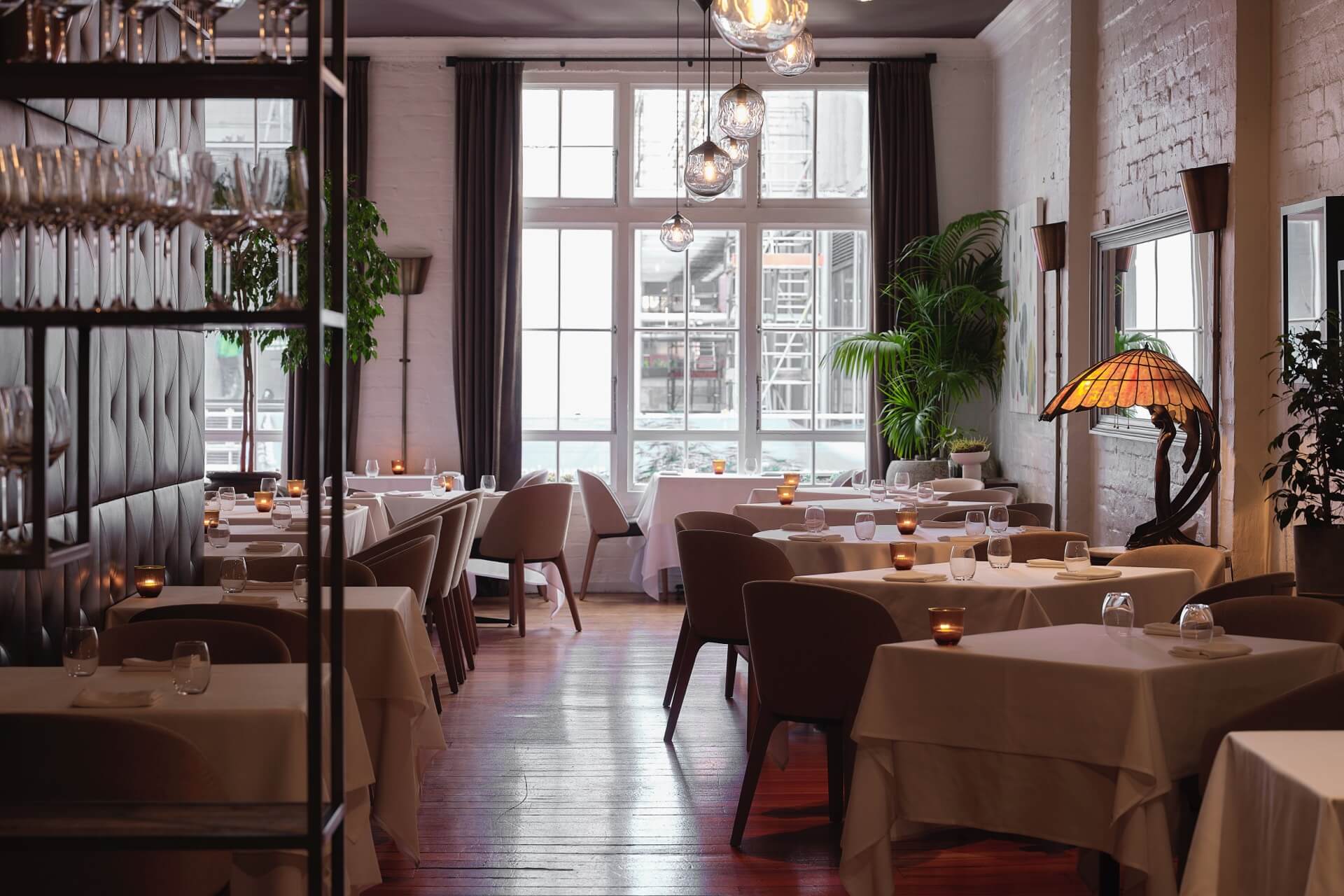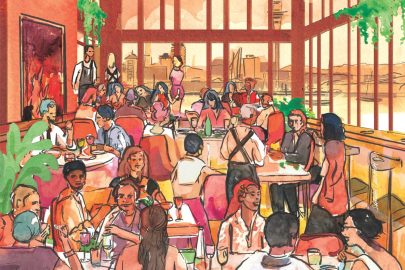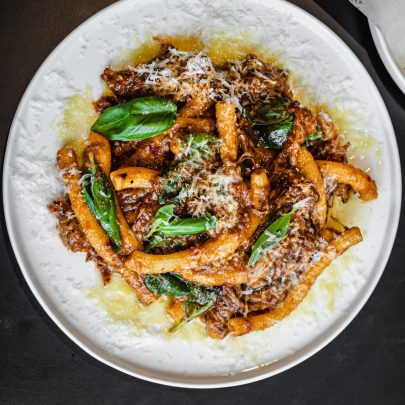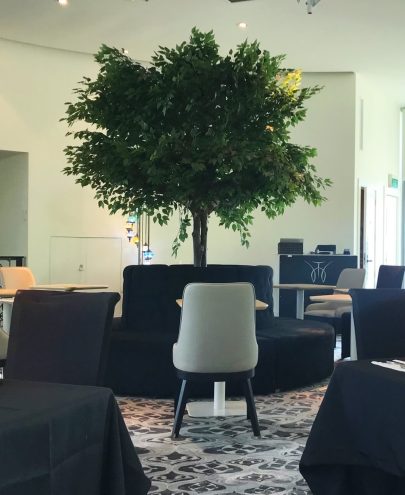Jun 19, 2024 Restaurants
Beware any kitchen with tweezers. That’s the apocryphal warning given by older chefs to young blood in kitchens around the world. They’re throwing shade on the Michelin-star elite — those run faster, jump higher, spherify this now! chefs. Food that’s art and food that’s science. But lately the world of fine dining that the film The Menu so gloriously roasted, in all its self-aggrandising, seemingly humourless excess, seems to be changing.
While words like ‘refined’, ‘elevated’ and ‘intricate’ abound on fine-dining restaurant websites, diners increasingly identify these spaces as uncomfortable, pretentious, impenetrable and impossibly expensive. The exclusivity of fine-dining restaurants is part of the appeal for some, but that exclusivity, conversely — and obviously — means some people feel excluded.
After decades of glorification in books, social media and on TV, more recent portrayals — including in both investigative journalism and straight-up fiction — have left many with the impression that kitchens in fine-dining restaurants are relentlessly grim, if not downright exploitative. I can’t tell you how many people have watched the television series The Bear and asked me whether fine-dining kitchens are actually like the one portrayed. The answer is yes. And also no. Universally true or not, many have come to associate fine dining with bullying, swearing and machismo, and pressured, underpaid, overworked labour.
Last year, Noma, the Copenhagen fine-dining restaurant considered by many to be the best in the world, announced it would be closing. The decision came just a few months after Noma was pressured into beginning to pay the small army of interns who made up the bulk of its kitchen: it seems the restaurant couldn’t meet the sky-high expectations and manage the budget without relying on an unpaid workforce. At the time, head chef René Redzepi lamented that the traditional fine-dining model “just doesn’t work”.
We’ve seen our fair share of notable exits from the Tāmaki Makaurau fine-dining scene over the past few years, too. In 2021, after 47 years of tripe, roast duck and French onion soup, Parnell restaurant Antoine’s closed. In June last year, we saw the closure of Karangahape Rd’s Alta , which had only recently moved from a tasting menu to à la carte in what I assume was a last-ditch effort to try to get bums on seats. The same month, Pasture in Parnell shut its doors. Undoubtedly Auckland’s most ambitious though ill-fated fine-dining project, Pasture had offered a rarefied 20-something-course, three-and-a-half-hour experience for $375 a head (and was subject to criticism for its treatment of staff in this magazine in 2021). And early this year, local fine-dining institution Sid at The French Café split into a new smart-casual restaurant Anise (70 seats, pan-Asian) and The French Café (30 seats, dégustation only). The former site of Sid at The French Cafe is now heavily skewed to a more relaxed type of service and a playful menu with broad appeal. White tablecloths have been replaced by clean wood and sleek lines, and the food is less fussy (and rather delicious). Even the art is strikingly colourful, joyful even.
It’s hard not to wonder whether these comings and goings reflect the deterioration — or possibly the transformation — of fine dining. Fine dining isn’t dead, but it does have an image problem.
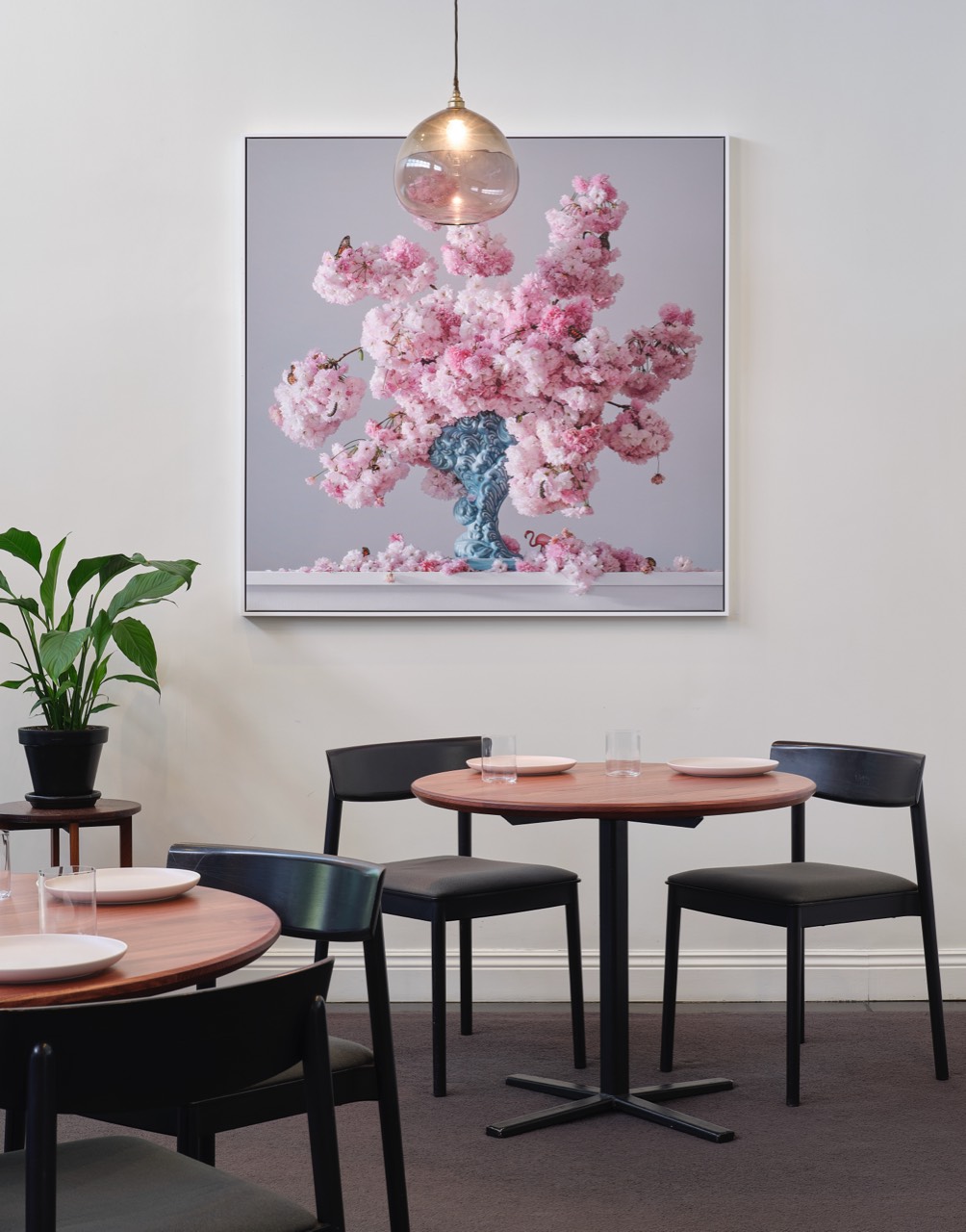
Anise
The term ‘fine dining’ is bandied about a lot in the food world, but the concept is amorphous and means different things to different people. Perhaps it’s a menu structured in a certain way, perhaps it’s the level of complexity. I think it almost always involves a hefty price point. Paris Butter on Jervois Rd, often described as a fine-dining establishment, says the restaurant “combines a fun and innovative yet refined ambience with a modern dining experience”. It offers a six- or eight-course “evolution” menu with a $120 wine pairing, in what I would describe as one of the more hushed and straight-faced dining rooms in Auckland. Chef Nick Honeyman says his idea of fine dining is about creating excellence in both food and service. “It is not so much the white tablecloths, it’s storytelling.”
I asked Henry Onesemo, the chef at one of our newest high-end establishments, Tala , what he thinks of when he hears the term. “It would have to be tablecloths, it would have to be rulered settings — there is a level of formality there,” he says. “Fine dining is traditionally that highest level of indulgence, but if the food moves you, is it fine dining or is it just good food?” Onesemo’s enthusiasm about food — all food — is infectious. He can wax lyrical about all sorts, from a perspective-changing fine-dining experience he had at Meredith’s on Dominion Rd to Indian fast food. Having set up Tala in the site previously home to Pasture and offering what reads on its website like a 13- or 17-course menu (it’s not — it comes out quick-fire, like a many-dish feast rather than lots of courses), Onesemo disclaims the fine-dining label. Seeing my scepticism, he explains with a grin that he prefers to call it “fun dining”.
‘Fun’ is an idea Sid Sahrawat (of Cassia , Kol , the recently name-reverted French Café and newcomer Anise) also adopts. The French Café has been an institution in Auckland’s fine-dining scene for four decades. Sid and Chand Sahrawat took it over in 2018, and the restaurant only recently secured an impressive score in La Liste’s 2024 rankings of international restaurants — the highest score in New Zealand, in fact, and by a fair margin. Despite that, Sahrawat doesn’t feel overly constrained by tradition.
“The whole tablecloth scenario is really vanishing,” he says. “It gets too mundane.”
Sahrawat makes a good point. I can count on one hand (and even then, perhaps only a finger or two) the number of restaurants in Auckland that still rock a white linen tablecloth.
Instead, says Sahrawat, “what matters is the service, the quality of the food, and the creative process of the food”. He talks about pampering, luxurious ingredients, polished service and “something that you can’t really recreate at home”. But he rejects any need to be overly formal about it. With Anise, I’d say, he has put his money where his mouth is — and to good effect.
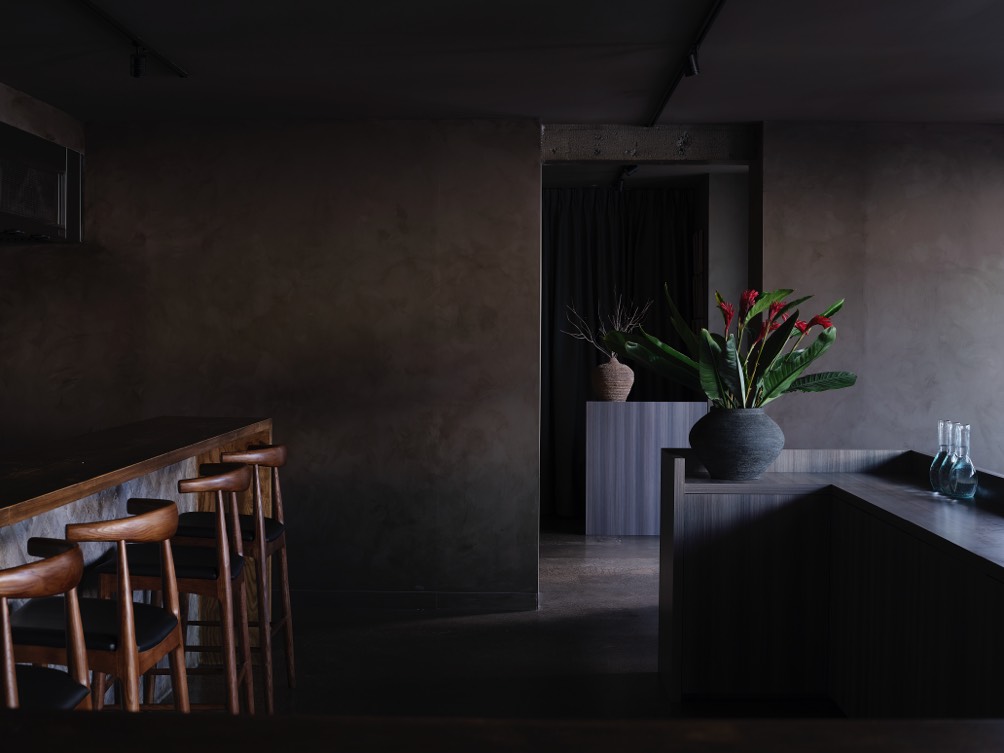
Tala
When Lillius opened on Khyber Pass in 2017, with a stylishly moody interior and plush banquette seats, chef Fraser McCarthy was reluctant to adopt the stuffy silver service and white tablecloths of conventional fine dining. Instead, he’s been guided by a more contemporary definition: a high level of service in a beautiful setting. The food at Lillius is stately in its presentation and clean in its flavours. It’s not casual, exactly, but it is relaxed.
“Fine dining is about trying to give the most luxurious version of something,” McCarthy tells me. There is a sense of transformation, perhaps even magic, to his food. “If customers knew everything I did, there would be no wow factor in it,” he says. “It’s exciting to go to a place where you don’t know everything that is going to happen or what you’re going to get.”
Chefs still aspire to create that sense of mystery and wow factor, despite the deeper knowledge of food and cooking techniques of a public obsessed with reality cooking shows. “There is always a risk in the magician showing his trick,” says Michael Dearth, owner of The Grove and Baduzzi . “But the art of a great magician, of a great creative mind, is the confidence that ‘I can show you this trick because I’ve got some more tricks’. I think it’s good to let people in.”
Hearing this attitude from Dearth is unsurprising, given that he is also a judge on MasterChef New Zealand. But he also puts his money where his mouth is on that. The Grove has been setting the bar for fine dining in Auckland for two decades now, and hews very closely to some traditions — dark wood, white tablecloths, dégustation only, a highly trained sommelier to guide you through the extensive wine list. The food feels thoroughly modern, though, and the kitchen has been a launching pad for a number of chefs over the years (including Sahrawat and McCarthy, as well as Michael Meredith of Mr Morris and Metita , and Ben Bayly of Ahi ).
The ‘magic tricks’ that Dearth speaks of are a hallmark of fine dining, where the food preparation is complex, technique driven, delivered by highly skilled chefs using specialised and expensive equipment. Even with the best willpower in the world, you just can’t make this at home. The joy of eating this food is partly in exclaiming ‘How did they do that?’ as you eat. In fine dining, time, like skill, is an important ingredient — and one often overlooked and undervalued by diners. It takes days to prepare the stocks, sauces, jellies, wafers and myriad other components in a fine-dining dish; weeks or months to dry-age meat, ripen cheese, pickle and ferment. These are ambitious restaurants and driven chefs, but feeding guests is only part of the show. Instead, what they present is art, invention and innovation.
“There is a level of obsession that goes into fine dining. No one else is willing to do that,” says Onesemo. “You risk almost everything you have to accomplish this, knowing that some version of what you are doing now will trickle down and become mainstream.” At Tala, he is trying to move the conversation about Sāmoan food forward. Or, more accurately, to properly begin one (something that Meredith is helping with, too, at his Pasifika restaurant Metita, which opened around the same time as Tala).
“Every cuisine has had a journey and Sāmoan food hasn’t had that journey yet. Sāmoan food just got stuck at the food markets and the takeaway, and not the sit-down format,” Onesemo says. “‘Māori’ and ‘Pasifika’: those are the only two slots, but we can be more ambitious! I want to be more specific about where I’m from. I’ve heard an Argentinian and a Colombian argue about what ceviche is. And Sāmoans and Tongans and Fijians need to have that argument about oka.”
We really are creatures of habit, so perhaps the best argument for the much-maligned dégustation or tasting menu format is that it opens us up to new ideas and perspectives — setting us up to be part of those conversations. “If Kiwis can’t pronounce a word on the menu,” Dearth says, with love but from experience, “they’re not going to order it.” That is why he loves having no menus. “You know the arsenal, the team that is behind you in the kitchen. We talk, we discuss, and you eat.”
Our fine-dining landscape is constantly growing and shifting. The conversation these days runs three ways: between the diner, the restaurant and the bottom line. Many of our leading restaurants seem to be listening and adapting. To make things more approachable, The Grove began using the label ‘snacks’ for its opening salvo about a decade ago. Snacks are now a common feature on Auckland restaurant menus, and a more relaxed mode of eating is common — at The Grove, Dearth says, they like to encourage diners to use their hands where the dish calls for it. The Grove has experimented at various times with the scope of its offerings, trying a dégustation of three or seven courses, then five or nine, now six or eight. That makes sense in an industry looking to strike the right balance between luxury and theatre while finding enough patrons to commit to a mid-week marathon meal. Nine courses was a bridge too far, apparently; three courses lacked that je ne sais quoi. Lillius has also tweaked its dégustation over time, added an à la carte menu and moved to BYO on Sundays. And if you add bread at the beginning and petits fours at the end, even a modest three-course tasting menu has a real sense of theatre. Not The Bear-style drama or The Menu-style tragedy, but the right kind of theatre. Oohs and aahs when food lands on the table. Wonder.
With tablecloths on the endangered-species list and the number of courses making up a dégustation in a constant state of flux, the gap between fine dining and ‘smart dining’ in Auckland has narrowed, maybe even disappeared. The Grove’s legacy is not just its own place as a long-term survivor of the industry, but in the sheer volume of good eating in Auckland that can be credited to its former chefs — the likes of Ahi, Origine , Baduzzi, Cassia, Kol, Sidart , Metita, Mr Morris, Apéro , even Jo Bro’s Burgers and Loco Bro’s Taqueria food trucks. Our handful of seriously high-end restaurants help seed the rest of our hospitality industry.
But, I hear you say, ‘Enough about them, let’s talk about me, Marie Antoinette: fine dining is expensive, and haven’t you heard there’s a cost-of-living crisis?’ Indeed. If money is tight, cutting out fine dining seems like a no-brainer. “If people can cook a piece of wagyu beef at home, they will do that — that is just the economic reality,” says Sahrawat. It’s not just fine dining that feels the effects of this belt-tightening: “People are going out a little bit less across the board.” Honeyman of Paris Butter says: “We’ve noticed a massive decline in our customers in the 30- to 40-year-old bracket who have mortgages.”
Fine dining has never been for the masses. But 35,000 Aucklanders this past February found room to manoeuvre around their mortgages to buy Synthony tickets, running to $180 for a premium ticket. Thousands spent $200+ (and in many cases $400 or more) to see P!nk at Eden Park in March. How many flew to Sydney or Melbourne or even Tokyo or Singapore to see Taylor Swift? For the target audience, it’s perhaps not a question of affordability, but of what people value.
Increasingly, we go to top-end restaurants only when we have something to celebrate — birthdays, anniversaries, graduations. At Lillius, where there is an à la carte offering, a regular customer is someone who drops by once a month; at Paris Butter, a couple of times a year. “If people don’t have mortgages, nothing has really changed for them,” says Sahrawat. “They still go out, and restaurants and cafes and bars that appeal to that demographic are still packed, but we are a special-occasion restaurant, so it definitely affects us.”
There will always be people who love the formality and exclusivity of fine dining and are able to pay for it. So while I don’t think fine dining has necessarily gone out of fashion, I do think it is at risk of going out of business if it doesn’t stay light on its feet. It may be hard to comprehend that restaurants which charge $150 to $200 per person just for food can’t make ends meet. But $45 to $50 mains are becoming commonplace even in smart casual restaurants, purely due to the cost of food. The sheer number of components, quality of ingredients and cost of labour to put it all together is meaningfully different in a fine-dining restaurant.
Fine-dining changes are a function of economics, but also — from what I can see — part of a shift away from focusing on the chefs and food as such. High-end dining is reorienting towards time spent with family and friends. We still see value in creative, luxurious food and will invest in that when we can, but financial realities are biting hard, even at the high end. So perceived value for money is key. Lillius has been operating with a one-man kitchen for some months now. It is light and lean, and the result of an evolving approach.
“When I first opened, I was so hungry and eager and wanted it to be a certain thing,” says McCarthy. “But when you’ve run a business for years, you realise that you have to be sustainable over what you want to do.” At Lillius, the top-end tasting menu is $200, but there is also an à la carte option with mains at the $48 mark. Either way, he says, “you leave here full”.
In the context of creative sustainability, the opening of Anise and the rebirth of The French Café seem both exciting and shrewd. Especially in the quieter summer months, some of our fine-dining establishments do well to attract 10 to 15 people in an evening — even down to single digits on a weekday. That is a hard circle to square if you’re carrying rent and all the other overheads. Anise may not be fine dining, properly called, but if this model is the future of high-end dining in Auckland, then I’m here for it. And it seems others are, too. So far, Sahrawat says, Anise has been running at perhaps 100 diners a night — not dissimilar to what Sid at The French Café was doing before the restructure, but with a smaller footprint.
Not everyone is looking to pivot. “If you start cooking just to make extra dollars,” Honeyman of Paris Butter tells me, “you’re going to change or damage your product. In the long term it’s not going to pay off.
“We’ve just tried to sharpen our pencil where we can and it seems to be going well.”
The Grove is also still flying the flag for a full dégustation. Dearth’s motto is “experience minus expectation equals value”. It doesn’t matter, he says, “if you’re selling a slice of pizza or an eight-course dégustation. Now more than ever, people want value.” At The Grove, they’re doubling down on maximising the experience element rather than fooling with a tried-and-tested menu format.
As more than one chef reiterated, New Zealanders love the shiny new thing, but are quick to move on. Given the pace of restaurant openings at the moment, it’s more than a full-time job to hold our interest. But there is no need to be overly pessimistic about the higher end of dining in Auckland. The Grove, after all, has made it through 20 years and all sorts of calamities — the global financial crisis, the St Patrick’s Square redevelopment, Covid-19, Cyclone Gabrielle, and ongoing construction on Albert Street which put a four-storey-high drill outside for a time. “In fine dining we have many struggles,” says Dearth — but he’s philosophical about that. “There are always cycles in life. I am a born optimist, a dreamer. I know that if you build it, they will come.”
As improbable as it might seem to the man on the street, our fine-dining chefs have their feet firmly planted on the ground. Their heads, though, are way up in the clouds — they’re looking to some of the most exciting, ambitious kitchens and wineries around the world, and then putting their money where their mouths are to show us how that might be expressed in a uniquely New Zealand way. This is serious food, at serious restaurants, even if they are no longer (all) humourless or overly formal. Some people like that. Some people never will. But it takes real grit to maintain these restaurants, because we’re a tough crowd at the best of times, and these are tough times. To pull off food like this takes art and a degree of arrogance — we don’t always know what we want until someone has the audacity to show us. And I think that’s glorious.

